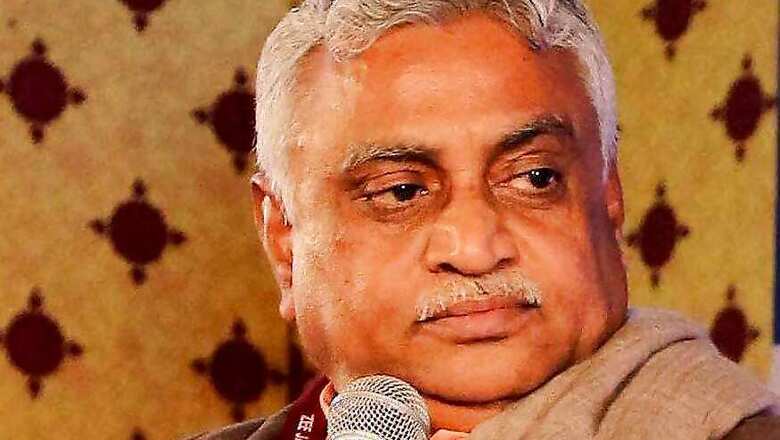
views
New Delhi: In an attempt to bolster the RSS’ Ram Mandir pitch, RSS joint general secretary Manmohan Vaidya has cited KM Munshi’s papers on his debate with Pandit Jawaharlal Nehru over the Somnath Temple in Gujarat, saying the centuries-old shrine was rebuilt despite the then PM’s opposition.
In an article written for the Sangh mouthpiece Organiser, Vaidya praised the Bharatiya Vidya Bhavan founder ahead of his birth anniversary on December 30. Acknowledging that the Somnath Temple and Ram Temple issues are different, Vaidya wrote: “The Supreme Court’s decision to not expedite the Ram Mandir case reminded me of a debate that took place in 1948 about the reconstruction of Somnath Mandir — a magnificent temple destroyed by the Muslim invaders.”
Munshi’s debate with Nehru over the Somnath Temple was recorded by the former in his book Pilgrimage to Freedom, which Vaidya elaborately cites in the article. “Despite opposition from Pandit Nehru, Somnath was rebuilt and today the shrine attracts lakhs of devotees from across the world,” Vaidya said.
The reconstruction of the Somnath Temple was initiated by Sardar Patel, then home minister, and was executed by KM Munshi, a cabinet minister in the central government. It was inaugurated by then president of India Dr Rajendra Prasad.
Vaidya writes that when Munshi went on a “sort of pilgrimage to the broken shrine” in December 1922, he saw it “desecrated, burnt and battered”.
“It still stood firm — a monument to our humiliation and ingratitude. I can scarcely describe the burning shame, which I felt on that early morning as I walked on the broken floor of the once-hallowed Sabha mandap...” Munshi wrote.
Sardar Patel and Pandit Nehru on Somanth
As per the account of KM Munshi that Vaidya discussed in the article, in November 1947, Sardar Patel visited the temple. At a public meeting, he announced, “On this auspicious day of the New Year, we have decided that Somnath should be reconstructed. You, people of Saurashtra, should do your best.”
Munshi also wrote about Nehru in his papers. “The temple of Somnath is not just an ancient monument; it lived in the hearts of the whole nation and its reconstruction was a national pledge. But Jawaharlal called me and said, ‘I don’t like your trying to restore Somnath. It is Hindu revivalism’.”
In his article, Vaidya writes that the difference of opinion between Patel, Munshi and Nehru is illustrative of “two different ideas of Bharat”.
“Pandit Nehru was not anti-Bharat but his idea of Bharat was rooted in a Eurocentric school of thought. On the other side was an idea of Bharat rooted in this soil and our ancient spiritual tradition,” he writes.
Munshi’s Response to Nehru
In his response to Nehru, Munshi wrote: “When the whole scheme was discussed by Sardar with Bapu, he stated that it was alright except that the funds necessary for reconstructing the temple should come from the public. Thereafter, the idea that the Government of India should finance the reconstruction of the temple was given up.
“You pointedly referred to me in the cabinet as connected with Somnath. I am glad you did so; for I do not want to keep back any part of my views or activities, particularly from you who have placed such abundant confidence in me all these months. I have helped in building up several institutions. If similarly I am now helping to build Somnath as a center of religion (Dharma) and culture, a university and a farm, it is only as a humble task to which I have been called…I can assure you that the ‘Collective Sub conscious’ of India today is happier with the scheme of reconstruction of Somnath sponsored by Government of India than with many other things that we have done and are doing,” Munshi wrote.
Replying to then PM’s ‘Hindu revivalism’ remark, Munshi said: “I know your views on the subject; I have always done justice to them; I hope you will equally do justice to mine. Many have been the customs, which I have defied in my humble way through literary and social work to shape or reintegrate some aspects of Hinduism, in the conviction that that alone will make India an advanced and vigorous nation under modern conditions.”
The reply to Munshi came from VP Menon, who was then advisor to the States Ministry. “I have seen your masterpiece. I for one would be prepared to live and, if necessary, die by the views you have expressed in your letter.”
And so the reconstruction of Somnath Temple went ahead. When the time came to install the deity, Munshi approached Dr Rajendra Prasad and asked him to perform the ceremony, but added a rider —he should accept it “only if he was prepared not to fail us”.
Munshi wrote, “He promised that he would come and install the deity whatever the attitude of the Prime Minister because he ‘would do the same with a mosque or a church if I were invited’.”
Claiming that Nehru “vehemently protested” Prasad’s acceptance of Munshi’s invite, Vaidya said that even the president’s speech was censored out of the official organs. “It is ironical that Nehru, the Indian icon of liberalism and freedom of expression, should make sure that the speech of the President is censored. In this manner despite opposition Somnath was rebuilt and today the magnificent shrine attracts lakhs of devotees from across the world,” Vaidya writes.
“History is repeating itself and the opposition to the Ram Temple in Ayodhya is even more vocal,” Vaidya added.




















Comments
0 comment